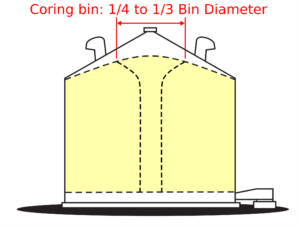Storing Drought Affected Grain
If your corn or beans suffered from the drought this growing season you are probably ready to be done with 2023 and ready to plan for 2024. However, if you store grain on your farm you shouldn’t forget about the 2023 crop going through the dryer or sitting in the bin. Preservation and optimization of grain stored on the farm, especially drought-affected grain, can greatly affect the dollars paid at the elevator this coming winter or spring.
Drought affected corn should be handled as carefully as possible. It is usually low in test weight and easily damaged compared to well filled corn kernels. To preserve test weight, consider drying corn slowly with low temperatures if possible. Low-test weight corn dried at 220℉ is on average 1.5 pounds per bushel lower in test weight than corn dried at 70℉. The result is a savings of around 4.5 cents per bushel in dockage fees.
Drought affected corn is prone to stress cracks and when moved through grain handling equipment can break causing many fines in the grain. The fines plug up gaps between kernels in the bin preventing adequate airflow, which, eventually results in moldy or rotten corn. Fines also act as a glue creating grain removal problems later in the season. To avoid this issue, clean the grain as it enters the bin or consider “coring” the grain bin immediately after filling. Cored grain should be cleaned, fed, or sold to a feed mill.

Illustration from James Dyck and Field Crops News
Soybeans affected by drought may dry down earlier than expected and many growers may be stuck harvesting soybeans below the standard 13% moisture. This is a bigger problem than many farmers realize. When you deliver beans to the elevator, you may be docked if they are too wet, but you will not be paid more if they are too dry. If you sell 10,000 bushels of soybeans at 10% moisture rather than 13% with a price of $12 per bushel, you are effectively missing around $4000 (calculated using the inverse shrink factor).
Adding water to grain to increase moisture is illegal in the US. However, there are a couple of strategies to avoid or counteract this problem. The easiest and least risky is to harvest on time when possible. Not only will this avoid the lower moisture levels, but also you are less likely to experience as much shatter loss from the combine header. If beans were harvested too dry, you may consider reconditioning them to add moisture and avoid missed revenue. This is done by turning on bin fans during the right weather conditions to slowly humidify the soybeans. Soybeans will reach an equilibrium moisture of around 13% when exposed to air with an average relative humidity of 70%. This process poses several risks, the greatest of which is bin damage due to expanding grain and the subsequent nullification of any warranty left on the bin. Another risk is over conditioning soybeans, which increases their moisture too much resulting in mold and rot along with other problems. While this process is risky, it can certainly pay off when considering the loss in profit calculated above. Some of the best resources for reconditioning soybeans safely come from Dr. Ken Hellevang a Professor and Extension Engineer at North Dakota State University (NDSU). Full instructions and safety considerations can be found in the NDSU soybean production guide at https://www.ndsu.edu/agriculture/sites/default/files/2023-01/a1172.pdf.
https://www.pioneer.com/us/agronomy/drought-stress-grain-harvest-cropfocus.html
https://www.canr.msu.edu/news/harvest_considerations_for_overly_dry_soybeans
https://www.ndsu.edu/agriculture/sites/default/files/2023-01/a1172.pdf
Written by Sam Bibby




